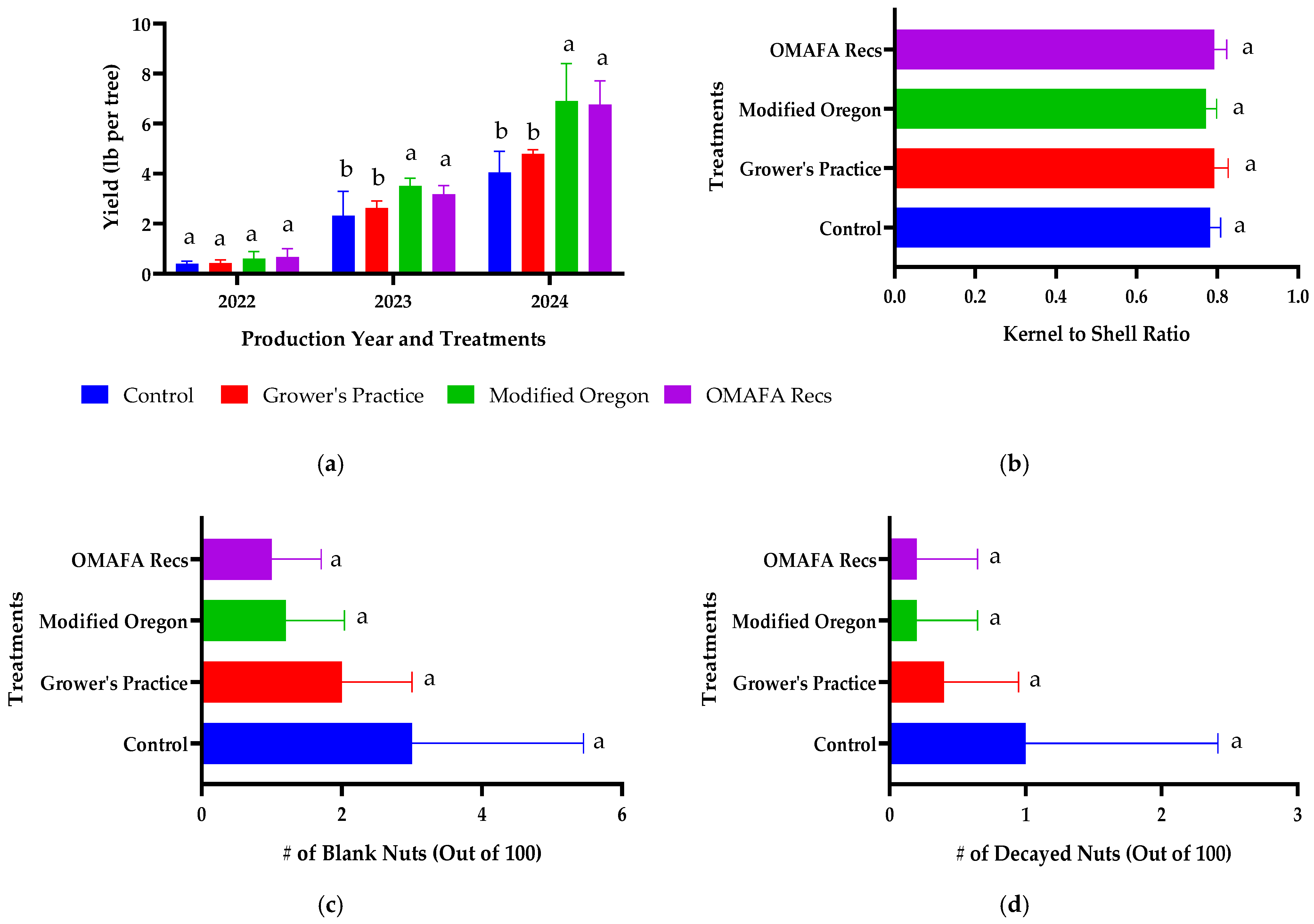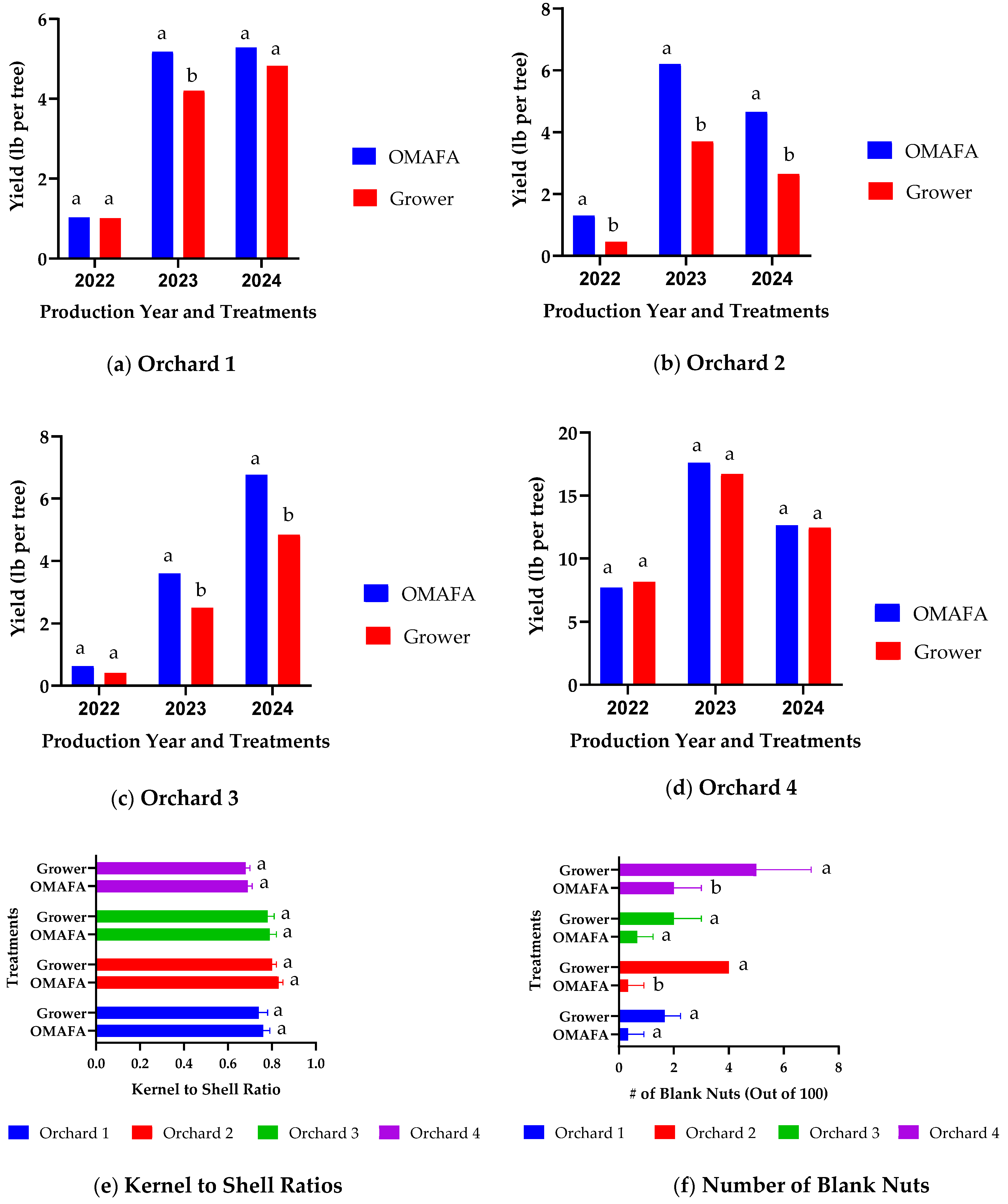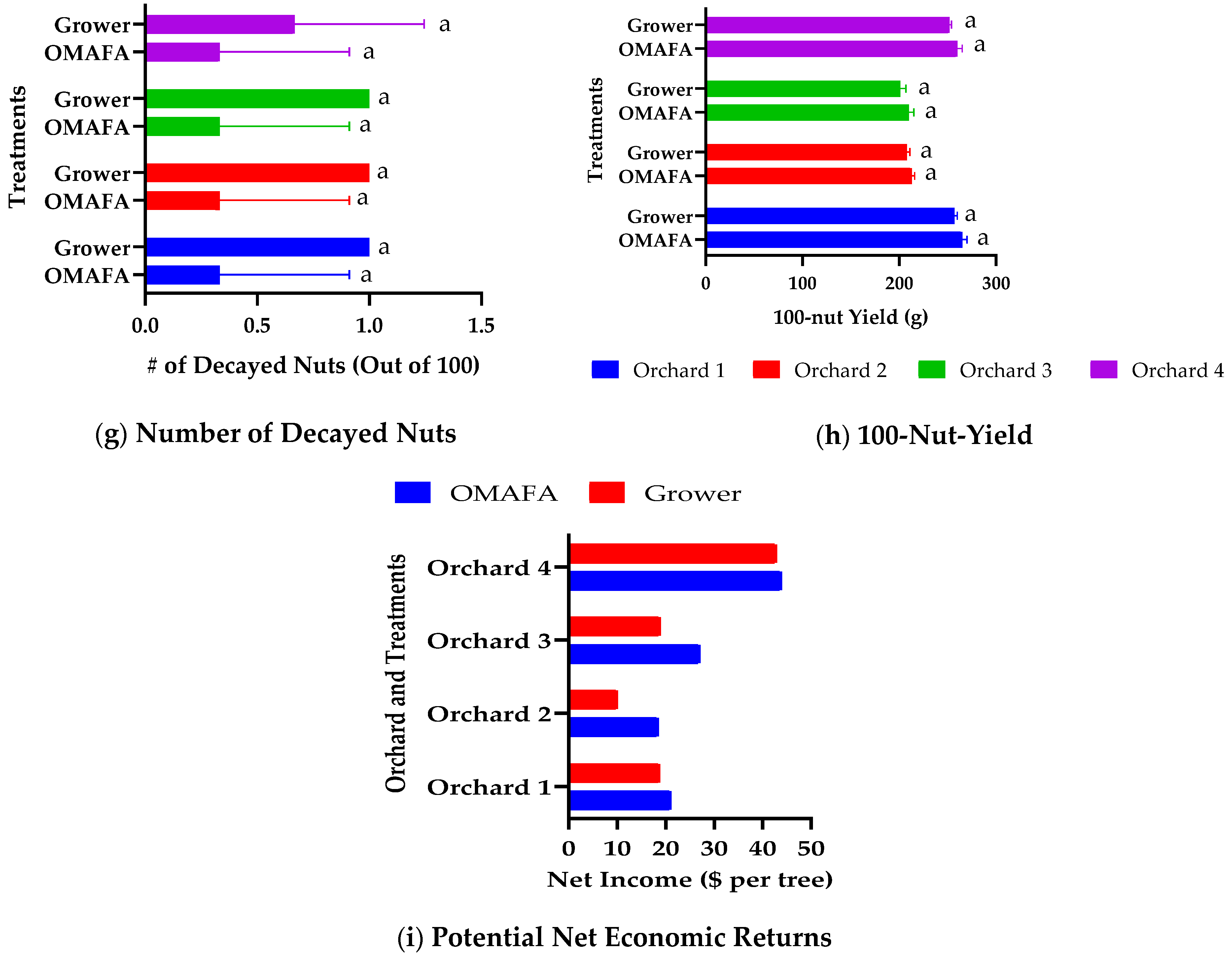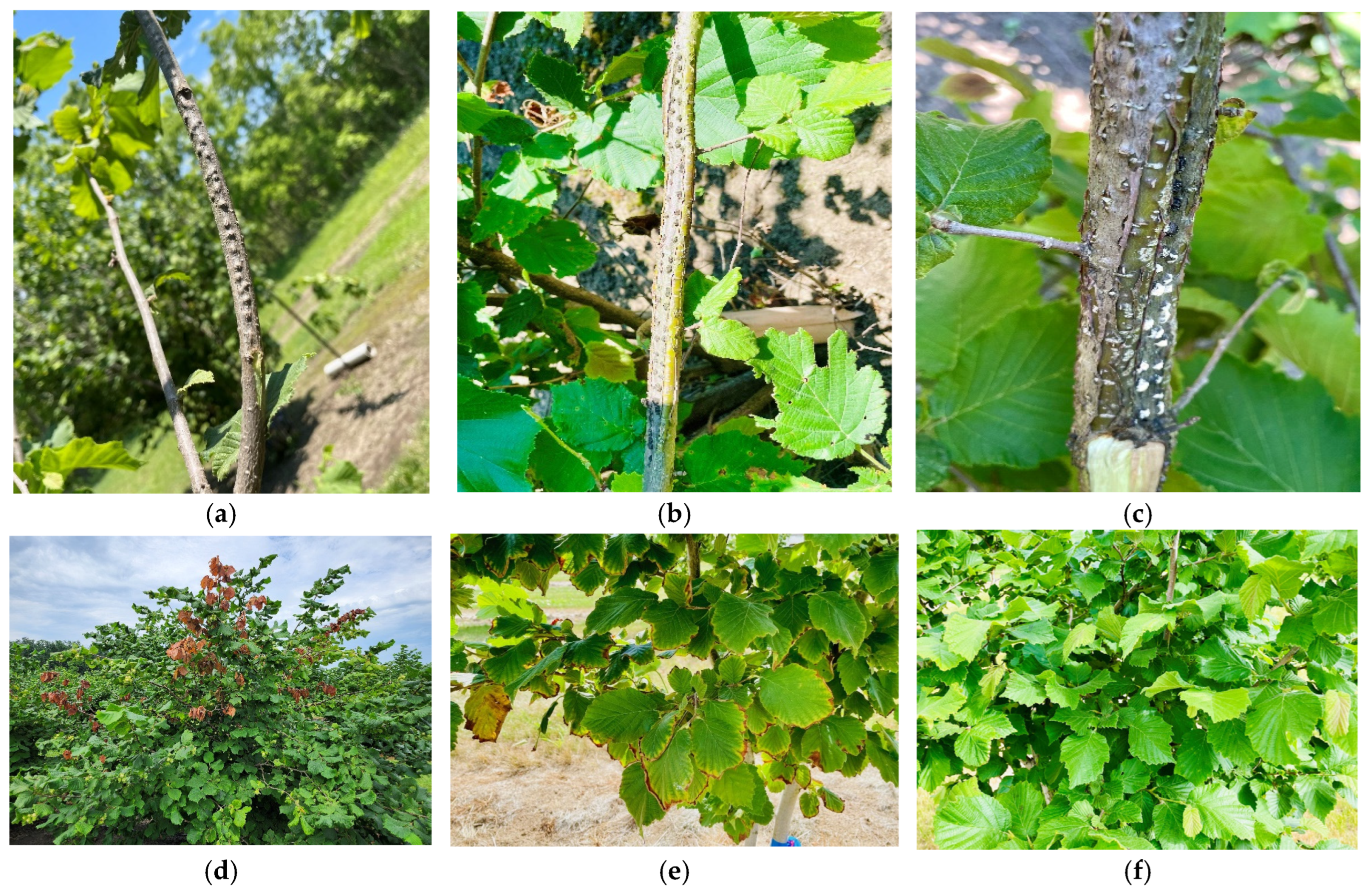Testing Different Fertility Treatment Regimes on Ontario-Grown Hazelnuts: Results from 3 Years of On-Farm Trials
Abstract
1. Introduction
2. Materials and Methods
2.1. Study Site, Climate, and Soil Description
2.2. Experimental Details
2.3. Data Collection and Analysis
3. Results and Discussion
3.1. Replicated Trials


3.2. Pilot Demonstration
3.3. Residual Nutrients
3.4. Disease, Pests, and Symptoms of Deficiency or Toxicity
4. Conclusions
Author Contributions
Funding
Institutional Review Board Statement
Informed Consent Statement
Data Availability Statement
Acknowledgments
Conflicts of Interest
List of Abbreviations
| ANOVA | Analysis of Variance |
| AS | Ammonium Sulphate (21-0-0, N-P-K) |
| EFB | Eastern Filbert Blight |
| GMS | Growers Mineral Solutions (10-20-10, NPK) |
| HCO | Horticultural Crops Ontario |
| K | Potassium |
| LOI | Loss-on-ignition |
| MAP | Mono-Ammonium Phosphate (11-52-0, N-P-K) |
| N | Nitrogen |
| OMAFA | Ontario Ministry of Agriculture, Food and Agribusiness |
| P | Phosphorus |
| PCC | Pearson Correlation Coefficient |
| SOP | Sulphate of Potash/Potassium Sulphate (0-0-51, N-P-K) |
| USA | United States of America |
References
- Drake, E. Opportunity Grows on Ontario Hazelnut Trees. Available online: https://www.uoguelph.ca/oac/news/opportunity-grows-ontario-hazelnut-trees (accessed on 10 January 2025).
- Food and Agriculture Organization of the United Nations (FAO). Hazelnut Production. Available online: https://www.fao.org/4/x4484e/x4484e03.htm#TopOfPage (accessed on 10 January 2025).
- Olsen, J.; Growing Hazelnuts in the Pacific Northwest. OSU Extension Service Bulletin: EM 9072. 2023. Available online: https://extension.oregonstate.edu/collection/growing-hazelnuts-pacific-northwest (accessed on 10 January 2025).
- Tobin, B. Big Plans for Ontario Hazelnuts. Available online: https://www.realagriculture.com/2017/10/big-plans-for-ontario-hazelnuts/ (accessed on 10 January 2025).
- OMAFA. Publication 863: Guide to Hazelnut Production in Ontario. Available online: https://www.ontario.ca/page/publication-863-guide-hazelnut-production-ontario (accessed on 10 January 2025).
- Liu, J.; Chapagain, T. Fertility Trials in Hazelnuts: Comparison of Oregon and Ontario’s Guidelines over Farmer’s Practice in Ontario; Ontario Ministry of Agriculture, Food and Agribusiness (OMAFA): Guelph, ON, Canada, 2023.
- Braun, L.C.; Gillman, J.H. Fertilizer nitrogen timing and uptake efficiency of hybrid Hazelnuts in the Upper Midwest, USA. Hort. Sci. 2009, 44, 1688–1693. [Google Scholar] [CrossRef]
- Ontario Soil Management Committee—OSMC. Fertilizer Guidelines for Horticultural Crops; Ontario Ministry of Agriculture, Food and Agribusiness (OMAFA): Guelph, ON, Canada, 2016.
- Environment and Climate Change Canada. Historical Data. Available online: https://climate.weather.gc.ca/historical_data/search_historic_data_e.html (accessed on 10 January 2025).
- Ontario Ministry of Agriculture, Food and Agribusiness—OMAFA. Soil Fertility Handbook: OMAFRA Publication 611. Available online: https://files.ontario.ca/omafra-soil-fertility-handbook-en-2022-10-13.pdf (accessed on 10 January 2025).
- Kizilkaya, R.; Dumbadze, G.; Gülser, C.; Jgenti, L. Impact of NPK fertilization on hazelnut yield and soil chemical-microbiological properties of Hazelnut Orchards in Western Georgia. Eur. J. Soil. Sci. 2022, 11, 206–215. [Google Scholar] [CrossRef]
- Özenç, N.; Özenç, D.B.; Duyar, Ö. Nutritional composition of hazelnut (Corylus avellana L.) as influenced by basic fertilization. Acta Agric. Scand. 2014, 64, 710–721. [Google Scholar] [CrossRef]
- Olsen, J. Nitrogen management in Oregon hazelnut. Acta Hort. 1997, 445, 263–268. [Google Scholar] [CrossRef]
- Olsen, J.L.; Righetti, T.L.; Sanchez, E.I. Absorption and distribution of isotopically labeled nitrogen in the hazelnut tree following ground and foliar applications. Acta Hort. 2001, 556, 437–444. [Google Scholar] [CrossRef]
- Weinbaum, S.A.; Johnson, R.S.; DeJong, T.M. Causes and consequences of overfertilization in orchards. Horttech 1992, 2, 112–121. [Google Scholar] [CrossRef]
- Dong, S.; Scagel, C.F.; Cheng, L.; Fuchigami, L.H.; Rygiewicz, P.T. Soil temperature and plant growth stage influence nitrogen uptake and amino acid concentration of apple during early spring growth. Tree Physiol. 2001, 21, 541–547. [Google Scholar] [CrossRef] [PubMed]
- Baron, L.C.; Stebbins, R. Growing Filberts in Oregon; Oregon Extension Bulletin 628; Oregon State University: Corvallis, OR, USA, 1981. [Google Scholar]
- Kowalenko, C.G. Interpretation of autumn soil tests for hazelnut. Can. J. Soil Sci. 1996, 76, 195–202. [Google Scholar] [CrossRef]
- Titus, J.S.; Kang, S.M. Nitrogen metabolism, translocation, and recycling in apple trees. Hort. Rev. 1982, 4, 204–246. [Google Scholar]
- Munoz, N.; Guerri, J.; Legaz, F.; Primo-Millo, E. Seasonal uptake of 15N-nitrate and distribution of absorbed nitrogen in peach trees. Plant Soil 1993, 150, 263–269. [Google Scholar] [CrossRef]
- Weinbaum, S.A.; Merwin, M.L.; Muraoka, T.T. Seasonal variation in nitrate uptake efficiency and distribution of absorbed N in non-bearing prune trees. J. Amer. Soc. Hort. Sci. 1978, 103, 516–519. [Google Scholar] [CrossRef]
- Rosen, C.J.; Eliason, R. Nutrient Management for Commercial Fruit and Vegetable Crops in Minnesota; University of Minnesota Extension Services: St Paul, MN, USA, 2005. [Google Scholar]
- Gray, D.; Garrett, H.E.G. Nitrogen fertilization and aspects of fruit yield in a Missouri black walnut alley cropping practice. Agrofor. Syst. 1999, 44, 333–344. [Google Scholar] [CrossRef]
- Alva, A.K.; Fares, A.; Dou, H. Managing citrus to optimize dry mass and nutrient partitioning. J. Plant Nutr. 2003, 26, 1541–1559. [Google Scholar] [CrossRef]
- Sanchez, E.E.; Chimera, H.; Sugar, D.; Righetti, T.L. Nitrogen management in orchards. In Nitrogen Fertilization in the Environment; Bacon, P.E., Ed.; Marcel Decker: New York, NY, USA, 1995; pp. 327–380. [Google Scholar]
- Jacobs, D.C.; Revord, R.S.; Capik, J.M.; Molnar, T.J. Eastern filbert blight resistant Corylus avellana identified from 20 years of germplasm introduction and evaluation at Rutgers University, New Jersey, USA. Front. Plant Sci. 2024, 15, 1502392. [Google Scholar] [CrossRef] [PubMed]





| Description | Sites | |||
|---|---|---|---|---|
| Orchard 1 | Orchard 2 | Orchard 3 | Orchard 4 | |
| GPS Coordinates | 43°16′12″ N 80°18′5″ W | 42°49′35″ N 80°38′40″ W | 43°2′53″ N 80°26′37″ W | 43°10′7″ N 79°21′5″ W |
| Elevation | 300 | 250 | 250 | 90 |
| Orchard Size (acre) | 12 | 13 | 10 | 8 |
| Tree Density | 15 × 9 ft2 =323 trees per acre | 18 × 9 ft2 =269 trees per acre | 18 × 9 ft2 =269 trees per acre | 18 × 16 ft2 =150 trees per acre |
| Orchard Age in 2022 | 6 | 6 | 4 | 10 |
| Variety | Yamhill | |||
| Soil Texture | Sandy Clay | Sandy Loam | Sandy to Black Loam | Sandy Clay |
| Drainage Characteristics | Moderately Fine | Moderately Coarse | Medium | Fine |
| Irrigation | Drip | Drip | Drip | No |
| Tile Drainage | Not in the trial site | No | Yes | Yes |
| Baseline Soil Fertility (0–20 cm depth) | pH: 6.9, OM: 3.2%, NO3-N: 8.5ppm, P: 11 ppm, and K: 101 ppm. | pH: 6.3, OM: 3.1%, NO3-N: 4 ppm, P: 47 ppm, and K: 101 ppm | pH: 7.3, OM: 4.3%, NO3-N: 12 ppm, P: 18 ppm, and K: 110 ppm. | pH: 5.4, OM: 3.2%, NO3-N: 3.9 ppm, P: 59 ppm. and K: 205 ppm |
| Months | Orchard 1 | Orchard 2 | Orchard 3 | Orchard 4 | ||||||||
|---|---|---|---|---|---|---|---|---|---|---|---|---|
| 2022 | 2023 | 2024 | 2022 | 2023 | 2024 | 2022 | 2023 | 2024 | 2022 | 2023 | 2024 | |
| May | 14.7 (80.1) | 12.9 (35.6) | 15.5 (90.2) | 15.1 (60.2) | 12.8 (30.7) | 15.0 (88.1) | 14.7 (80.1) | 12.9 (35.6) | 15.5 (90.2) | 14.1 (54.2) | 12.7 (44.8) | 15.9 (58.4) |
| June | 18.5 (45.7) | 18.4 (64.9) | 19.3 (91.1) | 19.0 (81.2) | 18.3 (79.9) | 19.5 (105.5) | 18.5 (45.7) | 18.4 (64.9) | 19.3 (91.1) | 19.4 (71.7) | 18.3 (65.3) | 19.6 (82.8) |
| July | 21.2 (50.2) | 20.8 (152.3) | 21.4 (186.2) | 20.9 (58.0) | 20.8 (124.9) | 21.2 (97.3) | 21.2 (50.2) | 20.8 (152.3) | 21.4 (186.2) | 22.1 (55.9) | 22.4 (95.9) | 22.6 (75.5) |
| August | 21.2 (40.9) | 18.4 (84.3) | 20.2 (39.3) | 20.7 (68.3) | 18.7 (79.1) | 19.7 (116.2) | 21.2 (40.9) | 18.4 (84.3) | 20.2 (39.3) | 22.2 (75.8) | 20.1 (75.0) | 21.5 (69.4) |
| September | 16.5 (68.6) | 17.2 (7.0) | 18.0 (24.5) | 16.3 (77.8) | 17.2 (64.1) | 17.5 (38.0) | 16.5 (68.6) | 17.2 (7.0) | 18.0 (24.5) | 17.9 (59.2) | 18.7 (20.8) | 18.6 (53.8) |
| Seasonal Average Temperature (°C) | 18.4 | 17.5 | 18.9 | 18.4 | 17.6 | 18.6 | 18.4 | 17.5 | 18.9 | 19.1 | 18.4 | 19.6 |
| Seasonal Total Precipitation (mm) | 285.5 | 344.1 | 431.3 | 345.4 | 378.6 | 445.0 | 285.5 | 344.1 | 431.3 | 316.8 | 301.8 | 339.9 |
| Treatments | Sites | ||||
|---|---|---|---|---|---|
| Orchard 1 | Orchard 2 | Orchard 3 | Orchard 4 | ||
| Ontario Tree Fruits | Nitrogen (Actual N) | 0–2 years: no application; 3–5 years: 120 g/tree; 6–7 years: 192 g/tree; 8–9 years: 245 g/tree; 10–12 years: 310 g/tree | |||
| Phosphorus (Actual P2O5) | 8–12 ppm: 140 g/tree; 13–15 ppm: 122 g/tree; 16–20 ppm: 102 g/tree; 21–25 ppm: 80 g/tree; 26–30 ppm: 60 g/tree; 31–40 ppm: 40 g/tree; >41 ppm: no application | ||||
| Potassium (Actual K2O) | 81–100 ppm: 160 g/tree; 101–120 ppm: 142 g/tree; 121–150: 122 g/tree; 151–180: 82 g/tree; >181 ppm: no application | ||||
| Modified Oregon | Nitrogen (Actual N) | 0–2 years: no application; 3–5 years: 114–150 g/tree; 6–7 years: 150–227 g/tree; 8–10 years: 227–340 g/tree | |||
| Phosphorus (Actual P2O5) | 8–12 ppm: 140 g/tree; 13–15 ppm: 122 g/tree; 16–20 ppm: 102 g/tree; 21–25 ppm: 80 g/tree; 26–30 ppm: 60 g/tree; 31–40 ppm: 40 g/tree; >41 ppm: no application | ||||
| Potassium (Actual K2O) | 0–75 ppm: 680–900 g/tree, 75–150 ppm: 450–680 g/tree; >150 ppm: no application | ||||
| Growers’ Management | 1% Growers Mineral Solutions (GMS; 10-20-10 N-P-K; 1 L in 100 L water); 4 applications starting from end of April/early May (i.e., bud break stage) at 2-week intervals; no application in July/August followed by fall application at leaf drop stage in October/November. | 2–3 applications of GMS through fertigation program, 10:20 dilution; applications start from mid-April (i.e., bud break stage) to late May at 2-week intervals. | 2–3 applications of Impact (6-24-6, N-P-K), 1–2 L in 200 L tank; applications start from mid-April (i.e., bud break stage) to late May at 2-week intervals. | 3% GMS (3 L in 100 L water): 5 applications from mid-April to June; no application in July–August followed by 1 application in the fall (October–November). | |
| Nutrients | Description | Severe Deficiency | Deficiency | Optimal | Excess |
|---|---|---|---|---|---|
| Nitrogen (N) | Critical Value (%) | <1.8 | 1.8–2.2 | 2.2–2.5 | >2.5 |
| Recommended N (lb/tree) | 3.0 | 2.0–3.0 | 1.5–2.0 | 0 | |
| Phosphorus (P) | Critical Value (%) | <0.10 | 0.11–0.13 | 0.14–0.45 | >0.45 |
| Recommended P2O5 (lb/tree) | Phosphorus deficiencies have not been observed in Oregon hazelnut orchards. | ||||
| Potassium (K) | Critical Value (%) | <0.5 | 0.5–0.7 | 0.8–2.0 | >2.0 |
| Recommended K2O (lb/tree) | 8.0–10.0 | 6.0–8.0 | 0 | 0 | |
| Treatment | Site | Soil Nutrients (ppm) | ||||||||
|---|---|---|---|---|---|---|---|---|---|---|
| NO3 Nitrogen | Phosphorus (P) | Potassium (K) | ||||||||
| Baseline 2022 | Spring 2023 | Spring 2024 | Baseline 2022 | Fall 2022 | Fall 2023 | Baseline 2022 | Fall 2022 | Fall 2023 | ||
| Grower Management | Orchard 1 | 8.48 | 7.24 | 6.08 | 11 | 11 | 10 | 101 | 100 | 98 |
| Orchard 2 | 4.04 | 4.14 | 4.67 | 47 | 44 | 43 | 102 | 99 | 99 | |
| Orchard 3 | 11.7 | 10.1 | 9.51 | 18 | 16 | 15 | 111 | 108 | 106 | |
| Orchard 4 | 3.88 | 3.43 | 3.28 | 59 | 56 | 54 | 204 | 201 | 199 | |
| Ontario Guidelines | Orchard 1 | 8.48 | 10.8 | 14.8 | 11 | 22 | 38 | 101 | 155 | 186 |
| Orchard 2 | 4.04 | 8.75 | 14.6 | 47 | 42 | 40 | 102 | 145 | 181 | |
| Orchard 3 | 11.7 | 12.9 | 15.4 | 18 | 28 | 42 | 111 | 157 | 187 | |
| Orchard 4 | 3.88 | 8.41 | 14.2 | 59 | 51 | 49 | 204 | 202 | 195 | |
| Treatment | Site | Fall Tissue Nutrients (%) | ||||||||
|---|---|---|---|---|---|---|---|---|---|---|
| Nitrogen | Phosphorus (P) | Potassium (K) | ||||||||
| Fall 2022 | Fall 2023 | Fall 2024 | Fall 2022 | Fall 2023 | Fall 2024 | Fall 2022 | Fall 2023 | Fall 2024 | ||
| Grower Management | Orchard 1 | 2.45 | 2.41 | 2.40 | 0.15 | 0.15 | 0.13 | 0.61 | 0.56 | 0.55 |
| Orchard 2 | 2.47 | 2.57 | 2.49 | 0.15 | 0.16 | 0.14 | 0.63 | 0.63 | 0.62 | |
| Orchard 3 | 2.32 | 2.30 | 2.28 | 0.16 | 0.16 | 0.14 | 0.72 | 0.67 | 0.61 | |
| Orchard 4 | 2.20 | 2.25 | 2.19 | 0.13 | 0.14 | 0.14 | 0.71 | 0.68 | 0.62 | |
| Ontario Guidelines | Orchard 1 | 2.59 | 2.79 | 2.82 | 0.15 | 0.16 | 0.19 | 0.57 | 0.76 | 0.87 |
| Orchard 2 | 2.62 | 2.70 | 2.78 | 0.16 | 0.18 | 0.21 | 0.73 | 1.01 | 1.09 | |
| Orchard 3 | 2.38 | 2.51 | 2.62 | 0.16 | 0.18 | 0.20 | 0.72 | 0.85 | 0.94 | |
| Orchard 4 | 2.35 | 2.49 | 2.59 | 0.14 | 0.16 | 0.19 | 0.71 | 0.87 | 0.92 | |
Disclaimer/Publisher’s Note: The statements, opinions and data contained in all publications are solely those of the individual author(s) and contributor(s) and not of MDPI and/or the editor(s). MDPI and/or the editor(s) disclaim responsibility for any injury to people or property resulting from any ideas, methods, instructions or products referred to in the content. |
© 2025 by the authors. Licensee MDPI, Basel, Switzerland. This article is an open access article distributed under the terms and conditions of the Creative Commons Attribution (CC BY) license (https://creativecommons.org/licenses/by/4.0/).
Share and Cite
Chapagain, T.; Liu, J.; Krolikowski, S. Testing Different Fertility Treatment Regimes on Ontario-Grown Hazelnuts: Results from 3 Years of On-Farm Trials. Sustainability 2025, 17, 1543. https://doi.org/10.3390/su17041543
Chapagain T, Liu J, Krolikowski S. Testing Different Fertility Treatment Regimes on Ontario-Grown Hazelnuts: Results from 3 Years of On-Farm Trials. Sustainability. 2025; 17(4):1543. https://doi.org/10.3390/su17041543
Chicago/Turabian StyleChapagain, Tejendra, Jenny Liu, and Sophie Krolikowski. 2025. "Testing Different Fertility Treatment Regimes on Ontario-Grown Hazelnuts: Results from 3 Years of On-Farm Trials" Sustainability 17, no. 4: 1543. https://doi.org/10.3390/su17041543
APA StyleChapagain, T., Liu, J., & Krolikowski, S. (2025). Testing Different Fertility Treatment Regimes on Ontario-Grown Hazelnuts: Results from 3 Years of On-Farm Trials. Sustainability, 17(4), 1543. https://doi.org/10.3390/su17041543






